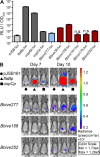In vivo expression technology and 5' end mapping of the Borrelia burgdorferi transcriptome identify novel RNAs expressed during mammalian infection
- PMID: 27913725
- PMCID: PMC5314773
- DOI: 10.1093/nar/gkw1180
In vivo expression technology and 5' end mapping of the Borrelia burgdorferi transcriptome identify novel RNAs expressed during mammalian infection
Abstract
Borrelia burgdorferi, the bacterial pathogen responsible for Lyme disease, modulates its gene expression profile in response to the environments encountered throughout its tick-mammal infectious cycle. To begin to characterize the B. burgdorferi transcriptome during murine infection, we previously employed an in vivo expression technology-based approach (BbIVET). This identified 233 putative promoters, many of which mapped to un-annotated regions of the complex, segmented genome. Herein, we globally identify the 5' end transcriptome of B. burgdorferi grown in culture as a means to validate non-ORF associated promoters discovered through BbIVET. We demonstrate that 119 BbIVET promoters are associated with transcription start sites (TSSs) and validate novel RNA transcripts using Northern blots and luciferase promoter fusions. Strikingly, 49% of BbIVET promoters were not found to associate with TSSs. This finding suggests that these sequences may be primarily active in the mammalian host. Furthermore, characterization of the 6042 B. burgdorferi TSSs reveals a variety of RNAs including numerous antisense and intragenic transcripts, leaderless RNAs, long untranslated regions and a unique nucleotide frequency for initiating intragenic transcription. Collectively, this is the first comprehensive map of TSSs in B. burgdorferi and characterization of previously un-annotated RNA transcripts expressed by the spirochete during murine infection.
© The Author(s) 2016. Published by Oxford University Press on behalf of Nucleic Acids Research.
Figures





References
-
- Adeolu M., Gupta R.S. A phylogenomic and molecular marker based proposal for the division of the genus Borrelia into two genera: the emended genus Borrelia containing only the members of the relapsing fever Borrelia, and the genus Borreliella gen. nov. containing the members of the Lyme disease Borrelia (Borrelia burgdorferi sensu lato complex) Antonie Van Leeuwenhoek. 2014;105:1049–1072. - PubMed
-
- Schotthoefer A.M., Frost H.M. Ecology and Epidemiology of Lyme Borreliosis. Clin. Lab. Med. 2015;35:723–743. - PubMed
-
- Groshong A.M., Blevins J.S. Insights into the biology of Borrelia burgdorferi gained through the application of molecular genetics. Adv. Appl. Microbiol. 2014;86:41–143. - PubMed
Publication types
MeSH terms
Substances
Grants and funding
LinkOut - more resources
Full Text Sources
Other Literature Sources
Medical

